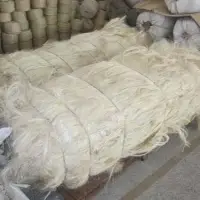
Raw Scotched Flax Fiber Long Fiber (HSCODE 5301.2100) Raw fiber which obtained from the water Retting flax straw by scotching 55 / 90 cm. Long in hand full about 200-250 gr each, 96-98% purity press in bales covert with jute weight of the One Bale 250 kg , for one 40 ft we can laded 25 Tons The Long of the Scotched Flax not less than 60 cm. length with cleanness not less than 96% can be used in producing yarns which are used for textile . Pressed in bales of 200 or 250 kg. ( With or without jutes) We got two grades from Scotched Flax. Grade A We produce between 200 and 300 Tons / Month. Grade B We produce between 150 and 300 Tons /
Raw Flax Fiber Scotched Tow Short Fiber Raw Scotched Tow Flax Fiber Short Fiber Length From 10 to15 cm and cleanness not less than 80% used for Textile Yarn and Flax Twine prepared and we have Scotched Tow flax fiber short fiber 2 stage process Every one ton Scotched Tow can Make Produce 700 tons cottoinized and 4 stage Scotched Tow Short Fiber (Every one ton Scotched Tow can Make Produce 9 00 tons cottoinized )process and we Pressed in bales of 200 or 250 kg. With or without jutes. Which is used in the manufacture of spinning factories. We produce between 400 and 500 Ton /Month.
Hackled Sliver Flax Bobbins Spools, Cones, ,Balls We have Baby Cones or Bobbins in different weight for both the sliver and the Bobbines or Cones: The weight of Bobbins or Cones is from 80 gr. till 500 gr. The weight of the Sliver is from 35 gr , 1.5 gr till 3 gr/mete. We can make the Bobbins Spools on Carton Tupe or in Plastic Cans spools Its length is available in 22 c.m.or 25 c.m. Its weight is available from 2 k.g till 10 k.g Boppines Its length is available from 10 c.m. till 27 c.m Its weight is available from 500 g.r. till 8 k.g.
Supplier: Plastic scrap (ldpe, pp, pvc, pet, pmma, hdpe, bopp, pe, ps, abs etc)., textile waste (cotton hosiery clips, cotton thread waste), denim, unbleached, selvedges rama string, rags for mattresses, wiping rags, licekrin dropings 100% cotton bales, card fly etc.) paper scrap
Supplier: Coir fibre bale, coir pith, coco peat, grow bags, coco chips, coir needle felt, coir geo textiles, rubberized coir(latex sprayed) sheets for mattress ,mulch mats and garden articles
Can supply: LICKERIN DROPINGS 100% COTTON BALES. Post industrial. Spinning mill waste. Can load in 1x40HC container approx.. 20 MT net. Ready for shipment. Photos available upon request. If you are interested kindly contact us for more information (price, available quantity etc.). You are welcome to visit our company premises and supervise our materials. Certificate ISO: 9001, ISO: 14001, OHSAS 45001, AQSIQ and CCIC.
Natural Sisal Fiber Type 1 Type 2 Type 3 Type 4 Sisal Fiber UG Grade Length: 110CM-130CM with a tolerance of 20%. Moisture: 10%-13% Impurity: 0-3% Classification per Grade: TYPE 1 - Colour whitish/soft cream, well brushed humidity maximum 14% without knots. Color: natural white, Brown and between white and brown. TYPE 2 - Colour cream/yellowish, well brushed humidity maximum 14% without knots. TYPE 3 - Colour cream/yellowish, well brushed humidity maximum 14%, without knots. REFUGOS (REJECT) - Colour brownish/green, humidity maximum 14%, presence of knots and high percentage of impurities. BUCHA (TOW) - Colour yellowish/brownish, humidity maximum 14%, presence of knots and a very high level of dust.
Coir fibre is the major product that is extracted from the coconut husk. Coir fibres have a multitude of different applications and they are available in blocks and bales as well. The coir fibres are generally used in the production of ropes, mats and mattresses. The coir fibres that are extracted from the inner layer of the outer part of the coir husk are used in large scale production of the ropes, mattresses and brushes. Coir fibre is also the main product used in manufacturing the geotextiles. Geotextiles have a wide range of uses. But it is mainly used in limiting the soil erosion. Soil erosion has become one of the most prevalent problems of our society. Although there are various methods for limiting it but the erosion can be successfully kept in check by the use of geotextiles. Moreover, the geotextiles are also used in various types of road works and for surrounding the dams.


